What a Holocaust survivor has to say to South L.A. school kids — and how she uses art to connect
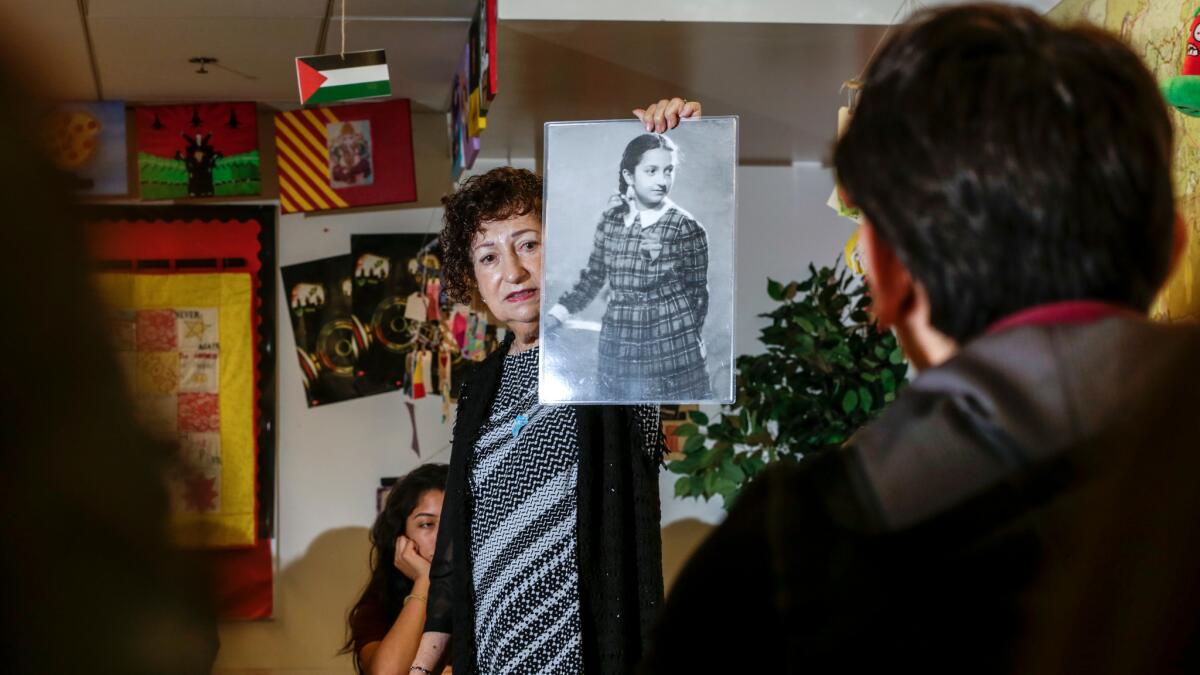
- Share via
The first period of any school day can be boisterous, with bells ringing, friends catching up on gossip and late arrivals rushing madly through doors. But early on a Thursday morning, the students in teacher Jon Aguado’s history class at Animo Ralph Bunche High School in Los Angeles are respectful and silent.
The only sounds are the low hum of a ventilation system and the soft voice of guest speaker Gabriella Karin recounting her chilling experiences in Slovakia during World War II.
Born to Jewish parents who operated a delicatessen in the heart of Bratislava, she was 11 when she and her family were forced into hiding — much like Anne Frank — to avoid deportation to a Nazi concentration camp.
“In this small, one-bedroom apartment were hiding eight people,” she tells the classroom, holding up a picture of the building in which her family hid as it looks today. “Imagine for nine months sitting on a chair and not being able to move. I could not talk.”
“We were always hungry,” adds Karin, who at 85 rocks a chic, asymmetrical bob. “There was never enough.”
The class is rapt.
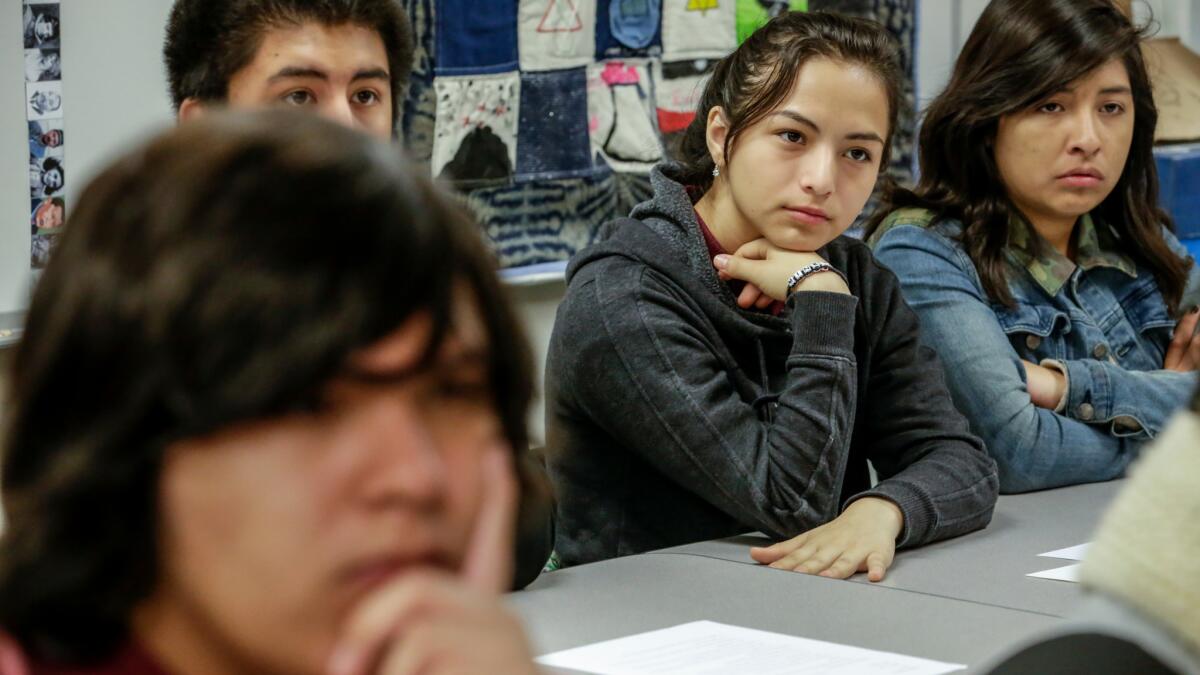
My name was not my name. My birthday was not my birthday.
— Gabriella Karin on living with false identity papers during World War II
When the presentation ends, with a few thoughtful questions from students and a round of applause, the kids, rather than delving into a deep discussion about the history of the Holocaust, reach for art supplies: markers and paint brushes and paper and stacks of Plexiglas discs that will serve as their canvas.
Karin’s talk — and the flurry of art-making that follows — is part of an innovative program established by the Los Angeles Museum of the Holocaust that uses art to teach public schoolchildren about the Holocaust.
For three years, the museum has partnered with three high schools and one junior high in underserved areas — Animo Ralph Bunche, Animo Watts High School and Alain LeRoy Locke College Preparatory Academy, all in South Los Angeles neighborhoods, and Hawthorne’s Prairie Vista Middle School — arranging for L.A. schoolkids to visit the museum and for guest speakers from the museum to visit those schools in return.
These exchanges culminate in collaborative class art projects — paintings, installations, group quilts and massive mobiles made out of Plexiglas discs — that the museum then displays in its galleries. (Currently on view is the mobile inspired by Karin’s talk.)
Aguado, the energetic teacher who helped spearhead the program, says that artistic engagement can offer a more profound connection to the subject matter than a lecture alone.
“For students, it can be hard to express their emotions and thoughts,” he says. “For these talks, we don’t ask them to write an essay. In this way, they can express themselves more fully without fear of judgment.”
In the process, his students get to learn about a dark chapter in history from those who lived it — and survived.
It helps me understand the importance of standing up for the right things.
— Sophomore Ximena Reyes
Samara Hutman, executive director at the museum, says the program offers a vital point of contact between L.A. schoolchildren and the last generation of Holocaust and Jewish World War II survivors, many of whom are now in their 80s and 90s.
“The art is so important because it really allows the kids to see something through other lenses,” she says. “Kids understand that these personal histories are valuable.”
“I feel like in a talk, you can miss out on the details,” says 16-year-old sophomore Ximena Reyes, who would one day like to be a journalist. “But with art, you can express the details, you can fill in the blanks.”
For her painting, she created a cave to represent the Holocaust. Out of it, emerge flocks of birds — her symbol for survivors.
“It helps me understand the importance of standing up for the right things,” she adds. “If everything stays quiet, nothing changes.”
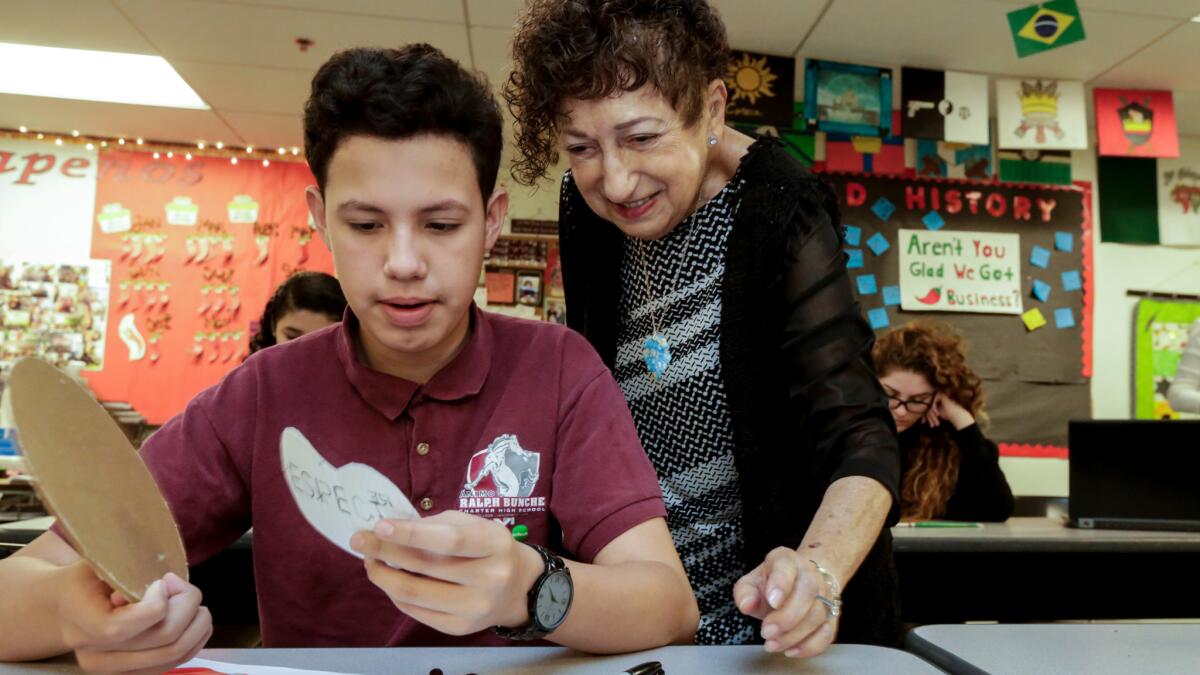
Share Our Stories: Reflections Through Art, as the program is called, was born of a conversation between Aguado and Hutman in 2013. Aguado had attended a teachers’ program at the museum and was touched by something the director had remarked on.
“Samara said that this generation of students will probably be the last generation to meet a survivor,” he recalls. “Those words always stuck with me. I always tell my students, ‘You are special that you get to do this.’”
But regular field trips to the museum for his history students were out of the question for financial reasons: “We just didn’t have funding for a field trip.”
That’s where the museum — and a grant from the Max H. Gluck Foundation — came in.
“We said, if you can’t come to the museum,” Hutman explains, “we will bring the museum to you.”
The pilot program was led by Aguado at Animo Ralph Bunche, where his students collaborated on a quilt inspired by the life story of a Holocaust survivor. (A number of these now decorate his classroom.)
“It was really about thinking, how do we break down the walls of the museum?” explains Hutman.
Karin, who has been involved with the Museum of the Holocaust for roughly two decades as a docent, guest speaker and exhibiting artist (she is a sculptor), says she is pleased to see the ways that her story can inspire others.
“It’s uplifting,” she says. “It’s seeing the kids create something that wasn’t there before.”
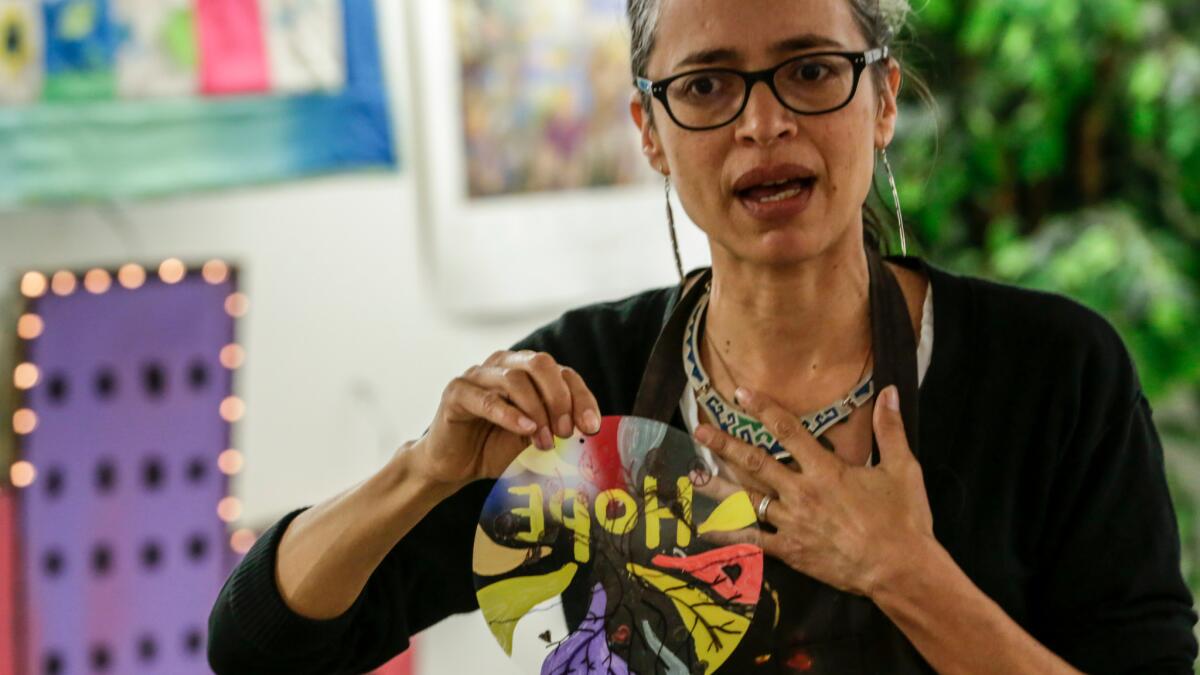
On the day that she speaks to the students at Animo Rulph Bunche, she recounts the story of her youth — an idyllic upbringing brought to a halt by the Nazi occupation.
When Karin was prohibited from going to school because she was Jewish, her parents created false identity papers that listed her as Christian and sent her off to a Christian boarding school where she says she often cried herself to sleep.
“My name was not my name,” she recalls. “My birthday was not my birthday.”
Everything can be taken from you — even the clothes you wear. But no one can take away what’s in your head, so put good things in there.
— Gabriella Karin
By 1944, the entire family was forced into hiding — stowed away by a family friend, a lawyer named Karol Blanar, who hid them in a small apartment building in central Bratislava whose bylaws didn’t allow Jews as residents. (Which means the Nazis were unlikely to search the place.)
To occupy herself during that period, Karin says she read everything she could lay her hands on — from Dostoevsky to Tolstoy.
“Everything can be taken from you — even the clothes you wear,” Karin tells the class. “But no one can take away what’s in your head, so put good things in there.”
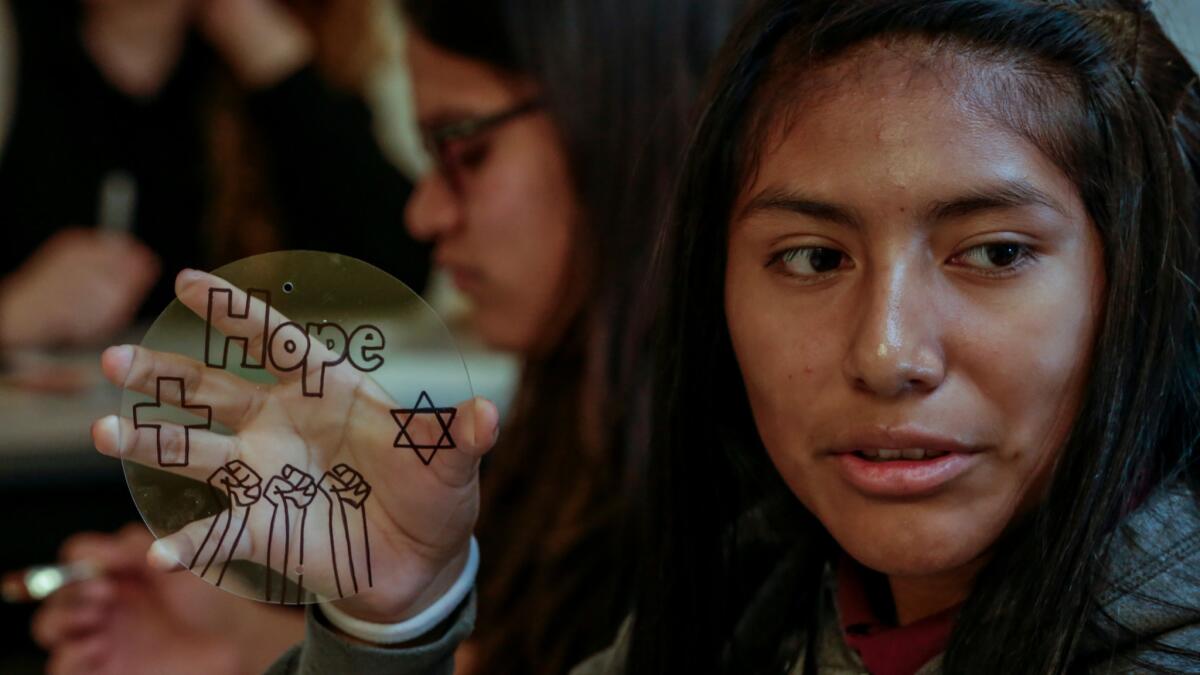
Her words resonate with the students, who write words such as “faith” and “hope” on the small plastic discs they’ve been given. One young man stencils out the phrase, “They can’t take what’s in your mind.”
Since the pilot in 2013, the Share Our Stories art program has been staged on various occasions at the participating schools. One student, Robert Lara, now a senior at Animo Ralph Bunch, was so taken with what he learned during his session that he ended up working at the museum as a summer intern last year.
“I got really into it,” he says. “It was just so interesting.”
In addition to the history lesson, someone like Karin can be an important point of inspiration to students in low-income, underserved communities — some of whom are the children of Central American refugees or refugees themselves.
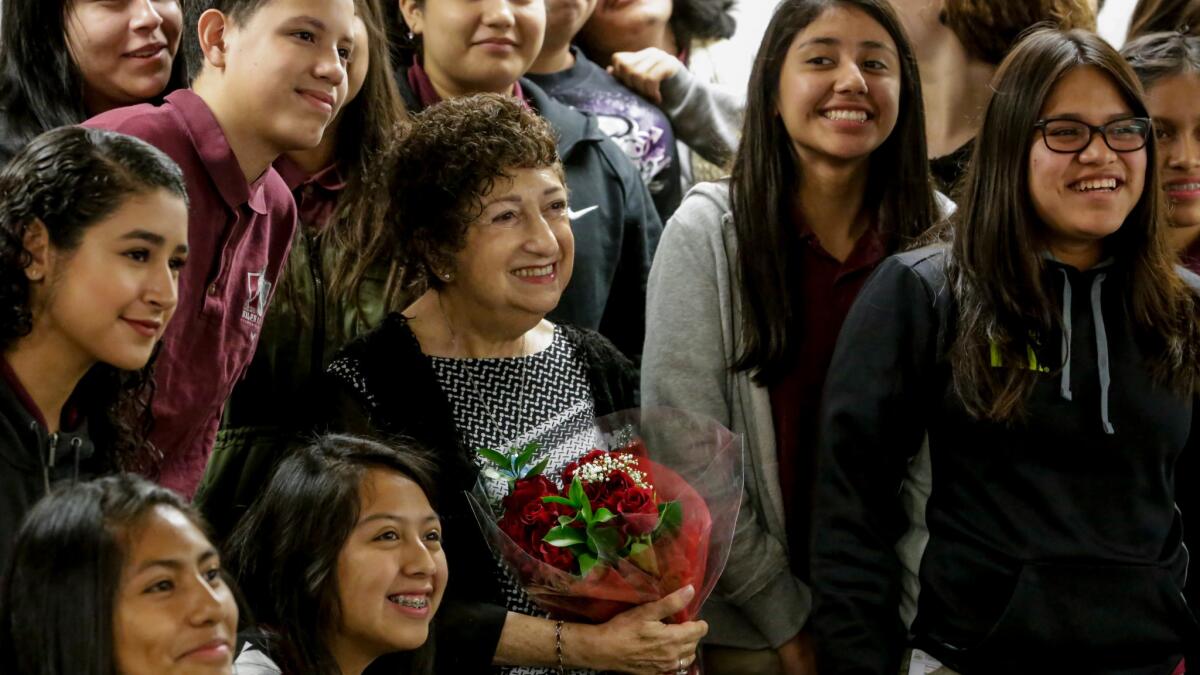
Despite the grim reality of the war years, Karin was able to move with her husband in 1960 to Los Angeles, where she had a long and successful career in the fashion industry. These days she is focused on making art and her volunteer work with the museum.
Recounting her life story — the bad and the good — can make a world of difference, says Hutman: “It’s someone who can say, ‘I’m OK. Things started badly for me, but I’m good now.’”
Aguado says that even after the sessions end, his students often continue to bring up their experiences from Share Our Stories. Some take their families to the museum to show off the collaborative artworks put on display.
“They continue talking about it,” he says. “The memory, it continues.”
+++
Art made by L.A. school children via Share Our Stories: Reflections Through Art
Where: Los Angeles Museum of the Holocaust, 100 S. the Grove Drive, Fairfax District, Los Angeles
When: Through Oct. 31
Info: lamoth.org
Sign up for our weekly Essential Arts & Culture newsletter »
Find me on Twitter @cmonstah.
To read the article in Spanish, click here
ALSO
The quest to retrace the tracks of seascape painter Childe Hassam
From ‘Beasts of the Southern Wild’ to ‘Burnpile’ at the Kirk Douglas: Lucy Alibar finds her voice
How scientists virtually unwrapped an ancient, burned scroll and read the words inside
More to Read
The biggest entertainment stories
Get our big stories about Hollywood, film, television, music, arts, culture and more right in your inbox as soon as they publish.
You may occasionally receive promotional content from the Los Angeles Times.











